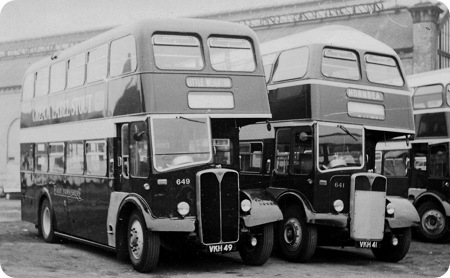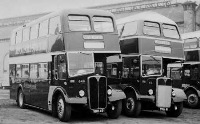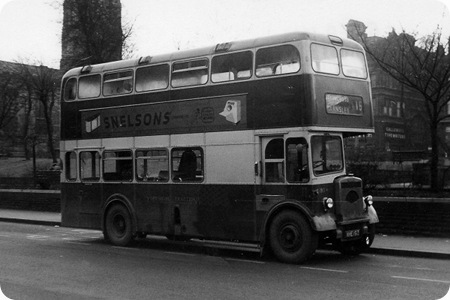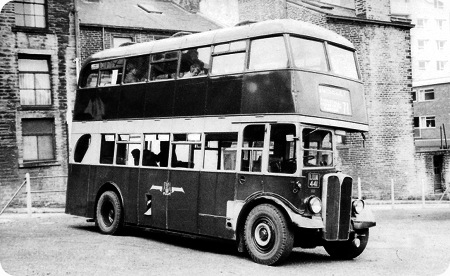East Yorkshire – AEC Regent V – VKH 47 – 649

Photo by ‘unknown’ if you took this photo please go to the copyright page.
East Yorkshire Motor Services
1957
AEC Regent V
Willowbrook L31/28RD
Now we have two Regent Vs from a batch of 19 delivered to East Yorkshire in 1956/7 they were fleet numbered 634 – 652.
634 to 648 were 27ft in length had AEC 7.68 litre six cylinder engines a four speed synchromesh gearbox and a Willowbrook highbridge ‘Beverly Bar’ style roof bodies seating 56 as per the bus on the right above.
649 and 650 had the same engine and gearbox but had Willowbrook lowbridge bodies seating 59 as per the bus on the left above.
651 and 652 were 30ft in length with AEC 9.6 litre six cylinder engines a four speed synchromesh gearbox but with Roe highbridge Beverly Bar style roof bodies seating 66. Another difference that 651 and 652 had was that they both had the more well known concealed radiator associated with the Regent V to see a shot of one of them click here.
With regards the above shot the bus on the right must have a cold running engine, that is a rather large radiator blanking panel. Getting a photo that shows the shape of the ‘Beverly Bar’ style roof is not easy as it was painted white and when shot in black and white the roof merged into the sky.
I wonder why East Yorkshire ordered nineteen of these Regent Vs and not twenty seems a strange number to order to me
A full list of Regent V codes can be seen here.
With regard to EYMS Regent V’s, there were two (or three) separate batches involved in the 19 vehicles referred to. The first batch was for 15 MD3RV;s 634 to 648, the highbridge ones, plus two lowbridge ones 649 and 650 (all were registered VKH 634-650) delivered November, 1956; plus two LD3RA’s 651 and 652 (registered WAT 651/2) delivered April, 1957. The numbering of these last two completed the gap between the first batch(es) and the first ex Everingham vehicle, which carried fleet number 653 (the whole series for Everingham vehicles was 653 to 664 plus 46!) These were acquired, of course, in November 1953.
Keith Easton
For many years the "Beverley Bar" VKHs were to be seen on the Leeds – Bridlington service (joint with WYRCC). I was a frequent traveller on them, having relatives then in Bridlington, and often went all the way smoking merrily with others in the lower saloon. EYMS were possibly the last operator in the Country to allow smoking anywhere in the vehicle ?? The Willowbrooks, fine in most ways, did though have possibly the worst sliding windows for incessant rattling. I wish we could still ride on them today when I travel in the present rattling thudding horrors that manufacturers are so proud of !!
Chris Youhill
Looks like the coach drop off point Bridlington coach station around the mid 60s
Mickey Summers
Sorry, Mickey – I think this is the main Hull bus park outside the railway station (in the background). This was the location where countless EYMS and KHCT buses would park off-peak, and was always a good place to take photos.
Paul Haywood
Yes, It is definitely the bus park now gone under ST Stephens shopping centre and Interchange. What a crime!
Keith Easton
I remember taking dozens of box camera shots on this site at Hull in the very early 1950s. There were rebodied Guys, TD4 and TD5s, some ECW rebodied, and some lowbridge all Leyland PD2s, as well as the usual BB Roe PD1s and PD2s, plus several single deck types inc the ECW PS1s, Burlingham coaches, and the usual "Federation" types. Fascinating fleet it was too. I particularly remember the oval rear windows of the pre war single deck stock (a bit of an out-dated feature) and the original 3 window upper fronts of the pre war Titans.
We used the Bridlington to Hull service many times, via Barmston, Beeford, Ulrome and Skipsea, and it always seemed to be on a Roe PD1, which I remember as quite lively.
An interesting fleet….perhaps it was the livery which held it apart from other BET fleets.
Does anyone remember the slogan on the sides of several Brush PS1s…. "This is not a nationalised bus" ?
John Whitaker
09/08/13 – 07:54
My great grandfather designed and built the first Beverley Bar bus, his name was William Bundy. He lived in Sproatley till his death at 99 in a house he built himself.
Bernice Brumby
09/08/13 – 09:30
Yes John, I do remember the slogan and there was another version on the cove panels of single deckers – it boldly and unashamedly proclaimed
"UN-NATIONALISED, UNIMPAIRED."
Chris Youhill
10/08/13 – 05:52
Wasn’t that the point of the white band around the roof? . . . to make the roof blend into the sky and look like a normal low-bridge roof? (In which case why not paint the whole lot white, rather than just a band around the roof . . . suggestions on a post-card).
Philip Rushworth
11/08/13 – 06:50
I’m surprised that no-one else has picked up on this. The title to this page gives the registration of EYMS 649 as VKH 47, Keith Easton gives it as VKH 649, while the photo clearly shows it as VKH 49. In fact, all of 634-50 were VKH 34, etc. While I’m on this subject of EYMS Regent Vs, could anyone tell me why EYMS suddenly bought two lowbridge double-deckers? Did they have a true lowbridge route, or were the two Regent Vs someone else’s cancelled order?
Also, how did Willowbrook come to build double-deckers to the ‘Beverley Bar’ outline? I thought the idea had emanated from a collaboration between EYMS and Roe, and had assumed that Roe had gone on to construct all the examples. (I don’t regard the Bridgemasters and Renowns as true ‘Beverley Bar’, they’re more like ‘pretend’).
David Call
11/08/13 – 09:29
Before the Second World War Brush built twenty-six Beverley Bar bodies and ECW twenty-one. Brush built more during the war (the PSV history and some published sources disagree as to whether all Brush bodies on the first Arabs were Bar buses) and ECW rebodied some Titans after the war whilst Roe rebodied the Arabs.
The Willowbrook bodies were a shock and are not regarded by many as handsome a design as the Roe bodies on various Titans (the full fronted ones excepted)
The bus park was useful to photographers, including myself, but for anyone wanting decent photos showing EYMS (or KHCT) at work in Hull it was a menace since many visitors rarely ventured outside this and the coach station.
The best "Bar" bus portraits ( they’re too good to be called photographs) were taken by G F H Atkins in Scarborough on his holidays, mostly at Northway.
Malcolm J Wells
11/08/13 – 09:29
David, I’m pretty sure but without looking deeply that East Yorkshire did need lowbridge buses somewhere in the outer west of Hull – possibly Elloughton ??
Chris Youhill
15/08/13 – 07:03
It would seem that East Yorkshire’s Elloughton garage was the main home of the company’s lowbridge buses.
The March 1962 and June 1965 editions of the Ian Allan ‘British Bus Fleets – Yorkshire Company Operators’ both show East Yorkshire as operating the following lowbridge double deckers:
584-589 (MKH 402-407) Leyland PD2/12/Leyland L53R 632-633 (SRH 632-633) Leyland PD2/12/Roe L56R 649-650 (VKH 49-50) AEC Regent V/Willowbrook L59R
(The 1965 edition shows the split of upper deck and lower deck seating capacities with 632-633 being L28/28R and 649-650 being L31/28RD. I had never personally noticed any lowbridge deckers with a capacity of more than 53 before).
I am not sure though that the 1962 book is totally correct as in some R H G Simpson photographs I have there were also (at least) 505/506 (JRH 978/979) which look like Leyland lowbridge bodies but the book lists these two as Roe HBB54R (the ‘HBB code used to identify Beverley Bar buses with highbridge layout seating).
In an EYMS allocation list dated 1 March 1962 584/585/586/588/633/649/650 were allocated to Elloughton and 587/589/632 were allocated to Hornsea.
The allocation list dated 1 October 1962 shows 584/585/586/588/589/649/650 allocated to Elloughton, 632/633 allocated to Hornsea and 587 allocated to Withersea.
The list dated 1 November 1963 shows 584/585/586/587/589/649/650 allocated to Elloughton and 588/632/633 to Hull (Anlaby Road).
The list dated 1 January 1964 shows 584/585/586/589/649/650 allocated to Elloughton and 587/588/632/633 to Hull (Anlaby Road).
Lists dated 1 April and 1 May 19 both show 585/586/589/649/650 allocated to Elloughton and 584/587/588/632/633 to Hull (Anlaby Road).
In the same allocation lists the Willowbrook Beverley Bar bodied AEC Regent V buses 634-648 (VKH 34-48), which I always really liked and frequently saw in Scarborough. These were mainly allocated to Driffield Garage – I suspect for service 12 between Hull and Scarborough. The exceptions being in March 1962 635/636/644 were allocated to Bridlington; in October 1962 635/636 were allocated to Bridlington; in November 1963 and January 1964 were 634/635/636 allocated to Hull (Anlaby Road); in April and May 1965 634/635/636/637/638 were allocated to Hull (Anlaby Road) and 648 allocated to Bridlington.
David Slater
15/08/13 – 11:58
Interesting information David. Given that the nearest railway line and station to Elloughton today is Brough, a line which doesn’t have any low bridges, I wonder if the offending structures were on the old Hull and Barnsley line around the North Cave/South Cave area?
Chris Barker
17/08/13 – 11:54
I knew I had seen something in print somewhere about where the low bridges were on the EYMS routes and I can quote the following from page 6 of the Venture Publications Prestige Series book on EYMS which reads: ‘The standard lowbridge types were in the fleet because of only two low bridges, one at Hornsea Mere station and the other near Selby’.
As an aside, the Prestige book also helped towards clarifying the point of the correctness of the 1962 Ian Allan British Bus Fleets book. The BBF book has grouped together in one block 50 Roe bodied Leyland Titan PD1A buses built between 1947-1950 and shows them all as ‘HBB54R’ – the code used to indicate a highbridge bus with Beverley Bar roof profile. These 50 buses are listed as: 447-453 (JAT 415-421); 471-498 (JAT439-466) and 505-519 (JRH 978-992).
However, as I mentioned before, I had photographs of 505 (JRH 978) and 506 (JRH 979) which I could clearly see were both lowbridge buses. The Prestige book shows a picture of 505 and confirms it was Roe bodied and not, as I had assumed, Leyland bodied – although the styling was very similar. So maybe these, the first two of the JRH batch were the only lowbridge bodies on that order and the list overlooked that fact. There is also a picture of 509 (JRH 982) which is a highbridge model.
David Slater
17/08/13 – 16:29
One has to be careful about sources
The OS/PSV history of 1980 shows the following
420-425 PD1 with Roe H52R bodies (later H56R)
426-427 PDI with Roe L51R bodies
433-453 PD1 with Roe H52R bodies (later H56R)
471-498 PD1A with Roe H54R bodies
505-507 PD1A with Roe L51R bodies
508-519 PD1A with Roe H54R bodies
The EYMS enthusiasts page says PD1, not PD1A
Which version is correct? I have no idea. The early Ian Allan books could be very inaccurate as shown in the first Yorkshire Municipal book’s entries for Hull’s 190-9/204-39 which contained no references to those rebodied with pre-war Massey and Weymann bodies from Regents and Daimlers, despite the fact that these had taken place 7-9 years previously.
The low bridge "near Selby" was, I think, at North Cave with the ex-Hull and Barnsley Railway Bridge although there may have been a problem at Willerby.
Malcolm J Wells
18/08/13 – 06:29
Malcolm, I had no idea that so many of the magnificent PD1s had been upseated from 52 to 56. Presumably a double seat was inserted each side in the upper saloons ??
Chris Youhill
18/08/13 – 12:00
As far as I am aware – yes. H30/26R instead of H26/26R, but I was a lad at the time and more interested in trolleybuses in Hull.
Malcolm J Wells
04/11/13 – 07:12
As a youngster I often travelled from Anlaby Common to Hessle to visit my Nana. The buses were always on service 3 Goole or service 4 Selby and if they were double-deckers they would be what we called "flat tops"- ie lowbridge. If for a change we walked through to Boothferry road to get a service 5 going to South Cave it was usually a "flat topper" too. For many years (1962 to 1969) I travelled to Beverley Grammar School from the Red Lion at Anlaby. For most of the time this was on the PD1A "JATs" and they went through Willerby without a problem so that bridge just short of Willerby Square mustn’t have been too low. Later we had the MKH full fronted PDs and latterly we had Bridgemasters or Renowns.
It is always good to see photographs of "the muck" behind Ferensway Coach Station – where I spent many happy hours noting numbers, collecting tickets and when the crew allowed setting the blinds for the next duty.
David Cornwall
04/11/13 – 16:50
Whilst the bus park alongside the coach station was very good for seeing lots of EYMS and KHCT buses many enthusiasts went no further so that photos of buses at work are in short supply. Photographs of EYMS elsewhere in the city in the 1950s and 1960s are rare – most pics show Scarborough, Bridlington and Beverley with hardly any in the suburbs for EYMS and very few KHCT ones outside the city centre.
Trolleybus enthusiasts tended to ride to and take pics at the outer termini as well as the city centre.
Until the KHCT head office was built in 1962/3 KHCT buses could also be found on what was bombed damaged land alongside the front of the garage in Lombard Street.
Malcolm Wells
 Vehicle reminder shot for this posting
Vehicle reminder shot for this posting
06/12/13 – 17:51
In common with several others who have posted EYMS comments, I too was – quote, unquote, a Grammar School git, who commuted between Willerby and Bev between 1963 and 1969. I must express particular gratitude to David Cornwall above, as he once lent me his 1964 copies of "Buses Illustrated" – I had only started buying it in 1965. I am delighted to see David remains interested in buses: my own enjoyment has never waned. Not being any good at maths, physics, Latin, games, woodwork – in fact not being very good at almost anything they tried to teach us at school – my nostalgia for those days is limited, but I would love to stop the clock and travel once again on the EYMS fleet of the mid-1960s. Our school run required about six buses each day, and almost anything from the fleet might turn up, even coaches on occasion. I was able to underline just about everything in the East Yorkshire section of my Ian Allen British Bus Fleets: Yorkshire Company Operators. My least favourite at the time were the JAT PD1s – Skidby Hill was always a challenge for them, but the AEC AV590-engined Bridgemasters and Renowns took it by storm, the Renowns being memorably melodious. I had a particular affection for the VKH Regents: ugly as sin, but what sounds they emitted, sweet AV470 melodies from the front, but a very rude raspberry of an exhaust.
Mark Evans
Quick links to the - Comments Page - Contact Page - Home Page


